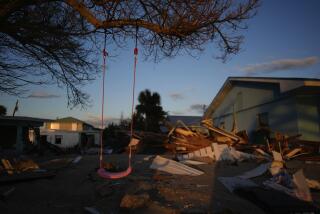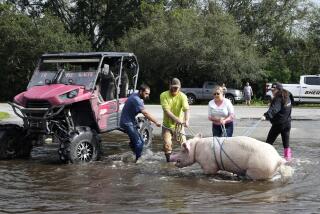Money Infusion Seen Speeding Miami Recovery
- Share via
MIAMI — For the first time since Hurricane Andrew swept through here eight days ago, mangling lives and landscape, thousands of southern Florida residents emerged from their damaged homes and debris-strewn neighborhoods Monday to go to work.
They ventured forth into a county in which more than half the 2,200 traffic signals still did not work, thousands of the palm and mangrove trees that gave the area its distinctive visual character had been knocked down and more than 250,000 homes and businesses still were without power.
But as companies struggled to reopen and the businesses that underpin Miami’s service economy began trying to rebuild in time for the coming tourist season, economic experts said that--despite Andrew’s debilitating punch--the renewal effort and the infusion of billions of dollars in disaster aid and insurance will spur a rapid economic recovery.
Depending on the quality of the rebuilding efforts and local leadership--and a few variables beyond local control--some say it is possible that in the long term the local economy could emerge in better shape than it had been in when the hurricane struck.
Unemployment in Dade County was at 10.4% and many businesses were in jeopardy of failing even before Andrew swept in. Southeastern Florida had lost 18,000 construction jobs alone in the last 24 months. The hurricane may have put an additional 140,000 people out of work, officials say.
Bruce Thomson, a labor market analyst for the state, said the storm has added 1 to 2 percentage points to the area’s unemployment rate, but he predicted the increase in joblessness will last for no more than two to three months.
“We will probably see hurricane-related construction-job growth going on for 12 months, with the majority of it going on in the first three to six months,” he said.
He predicted an increase of from 5,000 to 10,000 construction jobs. He noted, however, that the increase won’t make up for the jobs lost during the economic recession.
Steve Morrell, an economics professor at Barry University in Miami and former chief economist for Southeast Banking Corp., agreed that the rebuilding effort could offset the immediate surge in joblessness.
Beyond that, he said, if the destroyed homes and businesses are replaced with better-quality structures and if local political and business officials provide the right kind of leadership during the rebuilding effort, southern Florida could emerge with a stronger economy. “Isn’t that what happened in Germany and Japan after World War II,” he said.
Tourism accounts for about 275,000 jobs--a third of all jobs in the Miami area--but most areas frequented by tourists escaped the heaviest damage, and officials have begun making public appeals for visitors to come and spend money.
Indeed, while the hurricane affected the quality of life throughout the area and continues to cause frustration and inconveniences, severe damage was concentrated in the area south of Miami proper.
There, in small towns and migrant worker camps, life has been knocked back to a primitive level.
“I discovered abilities I didn’t think I had,” said Aaron Perez White, a 25-year-old restaurant worker left homeless by the storm. He said that in the days after the storm destroyed his apartment he cooked on a grill he fashioned from cinder blocks and a portion of chain-link fence.
Many of the 150,000 people still without shelter have been sleeping in automobiles or in ramshackle homes without walls or roofs. Heavy rains have slowed the erection of tent cities to house the homeless. Officials now say that 85,000 homes were rendered uninhabitable by the storm and will have to be razed.
One significant factor affecting the area’s ability to bounce back will be the future of Homestead Air Force Base, located in the heart of the hardest-hit area. With 8,700 civilian and military employees, it has added more than $400 million to the economy each year. The Pentagon has not yet announced whether the base, which sustained heavy damage, will be reopened.
Officials say Dade County suffered at least $20 billion in damage. The rebuilding effort is already beginning, though, as millions of dollars in government aid and insurance begin to flow in. State Secretary of Labor Shirley Gooden said the state has already received $10 million in emergency federal aid for jobs. Although she called the money “a drop in the bucket” and said the state was requesting more, she said the funds would be used to put people to work in the cleanup effort.
Gov. Lawton Chiles said Monday that if the federal government did not pay 100% of reconstruction costs, “the state of Florida will be totally busted.”
White House Press Secretary Marlin Fitzwater said President Bush was “quite sympathetic” to Chiles’ plea, but that no final decision had been made. Bush was due to arrive here today on a second inspection trip.
In one of the most depressed sections of inner-city Miami, an area that escaped heavy hurricane damage, 600 people who were unemployed even before Andrew struck packed a sweltering auditorium Monday morning to learn how they could find work helping Miami rebuild.
The Rev. Jesse Jackson and local black political leaders have pressed state officials to establish job programs so that the chronically unemployed could be put to work in skilled jobs. Jackson told the group Monday that the hurricane’s destruction provides an opportunity for Miami to put all of its unemployed people to work.
MIGRANT WORKERS SUFFER: Hurricane devastates Dade County agriculture. A10
More to Read
Sign up for Essential California
The most important California stories and recommendations in your inbox every morning.
You may occasionally receive promotional content from the Los Angeles Times.










